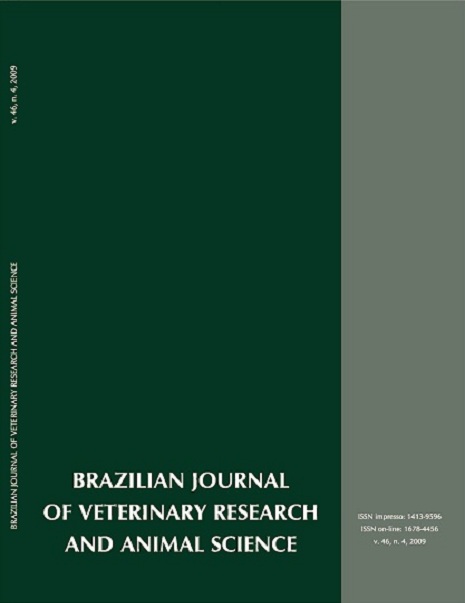Cytogenetic analyses of ocelot (Leopardus pardalis) and tigrinus (Leopardus tigrinus) oocytes collected after ovarian stimulation
DOI:
https://doi.org/10.11606/issn.1678-4456.bjvras.2009.26779Keywords:
Wildlife cats, Oocytes, Cytogenetic, ReproductionAbstract
This study represents the first assessment of oocyte's nuclear maturation by cytogenetical analysis in two endangered Brazilian felids: L. pardalis (n=5) and L. tigrinus (n=4). Females were treated 6 times with alternating eCG/hCG and pFSH/pLH protocols using an interval of 4 months between each treatment. Ovarian follicular development and oocytes recovery were performed through laparoscopy. Recovered oocytes were submitted to the morphological and cytogenetical analysis in order to evaluate the meiotic cycle and maturation (metaphase II), respectively. In 33 ocelot's oocytes observed 12% (n=4) showed condensed chromosomes and in 11 tigrinu's oocytes observed 36% (n=4) showed condensed chromosomes. However no oocytes in metaphase II were observed. Oocytes morphological evaluation showed the same characteristics were observed in others mammals. Our results suggest that L. pardalis and L. tigrinus do not show a decrease (p>;0.05) in ovarian response after repeated and alternate exposure to different gonadotropin treatments. In both L. pardalis and L. tigrinus, no differences (p>;0.05) were found regarding to the number of total ovarian structures (total follicles and CL) during successive gonadotropin treatments. There were no differences (p>;0.05) regarding to the total number of ovarian structures in L. pardalis (5.7 ± 1.2 eCG/hCG and 7.9 ± 0.9 pFSH/ pLH) or L. tigrinus (2.6 ± 0.7 eCG/hCG and 2.0 ± 0.5 pFSH/pLH). With these results we can suggest that follicular aspiration after ovarian stimulation with exogenous gonadotrophins results in immature oocytes, needing in vitro culture in specific mediums for metaphase II stage was observed.Downloads
Download data is not yet available.
Downloads
Published
2009-08-01
Issue
Section
UNDEFINIED
License
The journal content is authorized under the Creative Commons BY-NC-SA license (summary of the license: https://
How to Cite
1.
Paz RCR da, Adania CH, Barnabé VH, Barnabé RC. Cytogenetic analyses of ocelot (Leopardus pardalis) and tigrinus (Leopardus tigrinus) oocytes collected after ovarian stimulation. Braz. J. Vet. Res. Anim. Sci. [Internet]. 2009 Aug. 1 [cited 2024 Apr. 16];46(4):309-16. Available from: https://revistas.usp.br/bjvras/article/view/26779





